Shocked My Green Pool Now Its Milky Blue
Are you about to shock your pool, or have you already shocked it and are wondering if you can or have overshocked it? Is it possible to add too much shock to your pool? Perhaps your water has turned cloudy after shocking.
Well Big G has brought you to the right place.
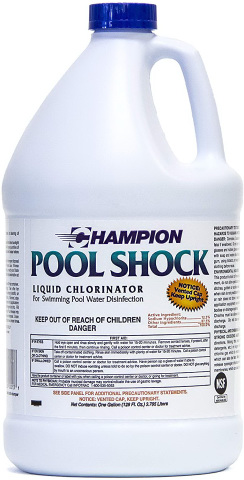
What happens if too much shock is added?
You cannot overshock a swimming pool or add too much. Adding too much shock or overshocking your pool will kill off algae. The negative of adding too much shock is it will upset the chemical balance of your pool.
It's likely to do that regardless of if you overshocked the pool or not. The pH will either go up or down depending on which product you used. You also won't be able to use the pool for a few days.
These things are easily fixed which we'll discuss further in the article.
For pool owners that have vinyl liners, be aware that you should avoid excessive shock granules settling on the bottom liner. Pool shock is a highly concentrated chlorine and may cause permanent damage to the pool resulting in leakages.
To avoid this, dissolve the shock first in a bucket with water. And when you add it to your pool, pour it in whilst walking around the pool so it doesn't all end up in the one place.
Is Too Much Shock Bad for Pool Equipment or Pool Plaster/Walls?
Too much shock is not usually a problem for a pool in the short term. It's not something you want to do on a regular basis though as it could damage the pool equipment.
When shock is added pool chlorine levels will rise much higher than normal and pH levels may rise or fall too. Having an incorrect pH means the chlorine will not be as effective and that can lead to algae problems when the chlorine levels are back down to normal.
Unbalanced pH isn't good for the pool equipment either.
- Low pH is acidic and causes pool equipment to corrode
- High pH is alkaline and can cause scale buildup on equipment and pool walls
To fix high pH, you can add a pH reducing product like muriatic acid or sodium bisulfate.
Further reading: How to Lower pH Levels
Use muriatic acid like this one to lower pH:
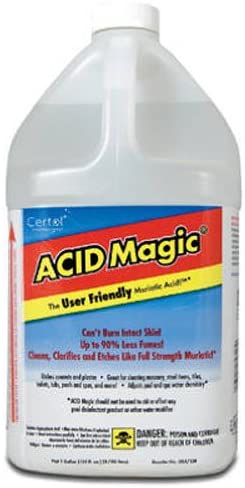
Click here to check the price >>
Or you can use pH Down (sodium bisulfate) like this one to lower pH:
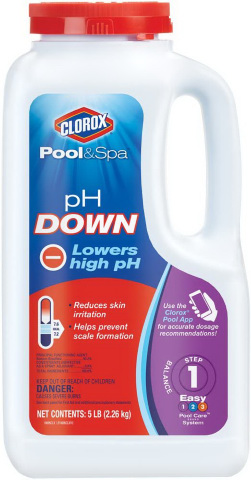
Click here to check the price >>
To fix low pH, you'll need to add Sodium Carbonate to the water.
Use a pH Increase like this one:
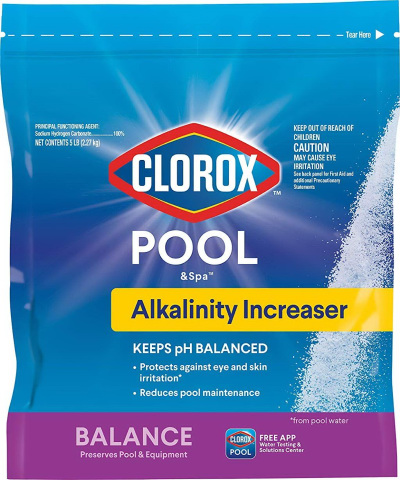
Click here to check the price >>
Further reading: How to Raise pH Levels
Another side effect of adding too much shock is additional calcium in the water. This only occurs if the shock you used was calcium hypochlorite. This type of chlorine will add calcium to the water. Liquid chlorine will not give you this problem.
If you already have soft water, that is water with high calcium hardness levels you may need to take steps to reduce the amount of calcium in your pool.
Too much calcium in the water means equipment can get scale and calcium build-ups. You may also notice a white build-up at the waterline on your pool tiles – this is calcium.
Lowering calcium levels is a bit more tricky than adjusting your pH levels.
You can try draining some of the water out of your pool and refilling it using a filter on your hose to prevent further calcium from entering the pool. This process is off removing some water is called dilution. You're draining some of the high calcium water out and diluting it with low calcium water.
Here's a hose filter you can use to keep the calcium out of the water as you refill the pool:
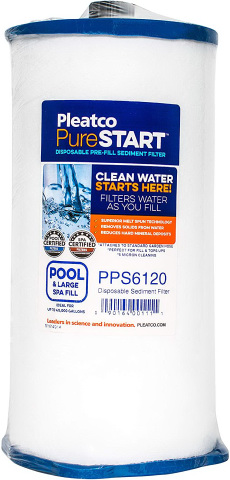
Click here to check the price >>
Can you Shock 2 days in a Row? Is it too much?
Shocking your pool for two days in a row is a valid and recommended strategy to kill and get rid of algae. In fact, the reason why algae comes back quickly is that the chlorine levels were not high enough for long enough to kill it off properly.
Depending on the severity of your algae outbreak you may need to shock your pool and maintain a high chlorine level of 15-30ppm for several days.
Algae growth severity can be classified into three categories.
- Light green algae
- Dark green algae
- Black green algae
Light green algae is less of a problem, whilst black green algae is the highest severity and may require you to maintain those high chlorine levels for a week.
Further Reading: Pool Green After Shocking | How to Fix
Why is Pool Cloudy After Adding Too Much Shock?
So you added some shock or possibly too much shock to your water and now your pool is cloudy.
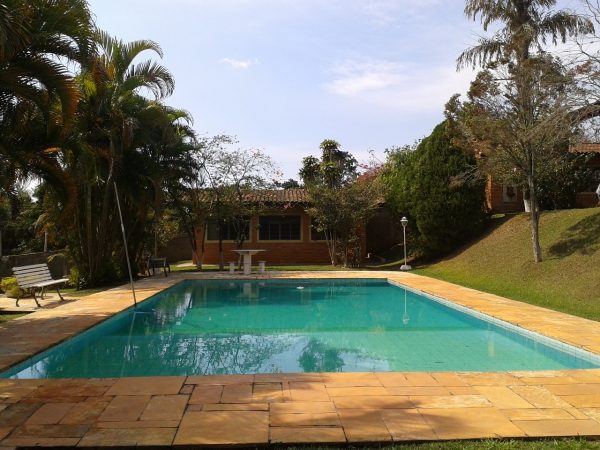
First of all, don't worry. Cloudy water after adding shock is common and not something you immediately need to panic about. The cloudy water isn't from adding too much shock.
Here is why your pool might still be cloudy after shocking:
1. Not Enough Filtration
Many people think that shocking is all that's required to make a pool crystal clear or that adding a double or triple dose of shock or chlorine will get rid of cloudiness. And they think it's an overnight thing.
Let's dispel that myth right here. Adding shock is only half the process on the road to getting rid of cloudiness or algae.
High levels of chlorine maintained for an extended length of time, also known as shocking, will kill off organics and bacteria in your pool's water. This leaves behind dead algae and microorganisms. Dead algae looks grey in color and will mean your pool water will look cloudy.
So how do you get rid of the cloudy pool water after shocking?
The next step of the process is to filter your water for 2-3 days continuously. Eight hours a day isn't going to cut it here. You need to run the filter 24 hours a day for a few days. Your pool contains a very large amount of water and it takes some time for all the water to pass through your pool's filter.
During this process of filtering, backwash or clean your filter a few times too to remove all the contaminants that have been filtered out. You may need to do this more regularly if your pool had a severe algae outbreak.
Chances are your pool will clear up after lots of filtering – just be patient. If it doesn't clear, you can always add a flocculent or water clarifier.
These products work in different ways. I suggest you try a clarifier first though as it will require the least amount of manual labor.
Further Reading: Pool Clarifier: How to Clear Up Cloudy Pool Water
Here's a pool clarifier you can use:

Click here to check the price >>
Here's a pool flocculent you can use:

Click here to check the price >>
2. High pH levels
pH levels pose great importance while shocking. A high pH level of 8 or more in water may result in ineffective shock treatment and create cloudiness in water. For effective water treatment, make sure you balance the pH of your water first so it's between 7 – 7.4.
You'll need to rebalance your pH levels and follow the filtering advice above to get your pool looking clear again.
3. You Recently Added a Metal Sequestering Product
If you have recently added a product to control stains or metals in your pool such as a metal sequestering product, you could likely see cloudiness in your water for a few days.
With lots of filtering, this should clear up.
4. Calcium Hardness Levels Out of Balance
A lot of the products marketed as Pool Shock are calcium hypochlorite. A by-product of this type of chlorine is calcium carbonate.
Too much calcium can lead to scale build-up and cloudy water. Particularly in warmer weather. Calcium is normally dissolved in the water but as the water warms, it is more likely to precipitate.
Make sure your calcium hardness levels are 100-400 ppm.
If you have high levels of calcium in your water, you'll need to drain some of the water to remove it. Next time, use liquid chlorine to shock your pool as it doesn't add calcium to the water like a calcium hypochlorite based pool shock.
How Long Should I Wait Before Shocking the Pool Again?
You should wait at least 8 hours before shocking your pool again. You really need to wait long enough for the shock to circulate and mix thoroughly. If you wait this long and need to add more shock, go right ahead. You can't over shock your pool.
In fact, you really should be thinking of shocking your pool as an ongoing process, not a one time thing. By that I mean, one of the main purposes of shocking your pool is to remove algae and clear up cloudy water.
And to achieve that, what you need to do is to add your shock then test the chlorine levels of the water night and day until you get rid of the algae and the pool's chlorine demand slows.
What is chlorine demand? When you have contaminants in your pool such as algae and organic matter, this "uses" up the chlorine. You may notice that at first your chlorine levels were up a lot and when you tested the next day, they were back down again. This could be chlorine demand.
If you notice the chlorine levels have dropped, make sure you have 30-50 ppm of stabilizer in the water then add more pool shock (chlorine) to bring the levels back up. Continue doing this until you can leave the pool overnight without the chlorine levels dropping significantly. And keep the filter on!
Is Adding Too Much Shock Bad for Swimmers?
Too much shock in the water is a danger to swimmers. Adding shock to your pool's water will affect the pH balance as well as the chlorine levels. Depending on if you used liquid chlorine or a shock like calcium hypochlorite, your pool's water could be either too acidic or too alkaline.
An acceptable pH level for a pool is between 7.4 and 7.6 for swimming. This is the level that is safe and comfortable for swimmers. An incorrect pH level can cause itchy skin, irritate the eyes and is not pleasant to swim in.
You should wait until the chlorine levels and the pH levels are back in the normal range before swimming.
How Long Should You Wait to Swim After Adding Too Much Shock?
After adding pool shock, you will need to wait between 1 and 4 days for it to be safe to swim in again. Before swimming the chlorine levels must fall back down to an acceptable range which ideally is 3-5ppm.
The amount of time it takes for this to happen really depends on how much stabilizer is present in the water, how much sun your pool gets and the organic material in the water.
You can speed up the process by making sure your swimming pool cover is removed. This will ensure the sun's UV rays are entering the pool.
It's also important that the water is clear again and the pH levels are correct. When you've got all this right, you can safely swim in your pool again.
Final Thoughts
Shocking, isn't it? It was that easy!
There is nothing like the wrong hit. If you get to get a hold of all the rights that give you a crystal clear, flawless pool, you are on top of mastery!
Now is the time to not worry about any season end or a poolside party night; enjoy to your fullest and shock like a pro, right when needed.
Related Reading: Do You Need to Shock Hot Tubs?
lawrenceglact1990.blogspot.com
Source: https://www.myperfectpool.com.au/can-you-overshock-pool.html
0 Response to "Shocked My Green Pool Now Its Milky Blue"
Post a Comment